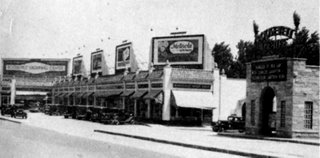
The Ideal's latest incarnation, at the same old address of 2447 E. Walnut, is that of an 8-plex apartment building. The new front awning and façade completely obliterate what little was left of the red and black deco tile from its theater days--in fact the only theater element I could see that still remained was the awning supports, still hanging down across the face, holding up nothing.
This photo is from my recent trip back to Des Moines, during which I tried to film/photograph whatever I could find for my documentary--a difficult task since there is even less to find than ever before! The screen at the Plantation was gone, and numerous locations (Eastown/1536, Amuzu, Capitol Drive-In, and others) were vacant lots--not a scrap of rubble to be found. The fine folks at Ed Garner's Autorama were nice enough to let me poke around their RV lot--formerly the Pioneer Drive-In--and shoot the screen there, nearly blocked by 20-odd years of tree growth. (They said the marquee sign was back there somewhere, but I couldn't find it at all.) Oddest of all, the Forest Theater building was constantly in the news--currently the home of Creative Visions, which is being audited very publicly.
On the upside, Des Moines appears to be finally putting some faith in itself again--everywhere, massive construction and renovation. Lots of old downtown buildings converted to living quarters again. New bridges everywhere. A vastly improved MLK parkway. Good going, gang.
Now just get a decent parking lot near the Ingersoll and get that opened up again, and you'll be all right!
 Check out the Roosevelt Theater (or, as you probably know it, the Playhouse) back when it was nearly new in 1935, and check out the Roosevelt Shopping Center, with all its winged billboards.
Check out the Roosevelt Theater (or, as you probably know it, the Playhouse) back when it was nearly new in 1935, and check out the Roosevelt Shopping Center, with all its winged billboards.


